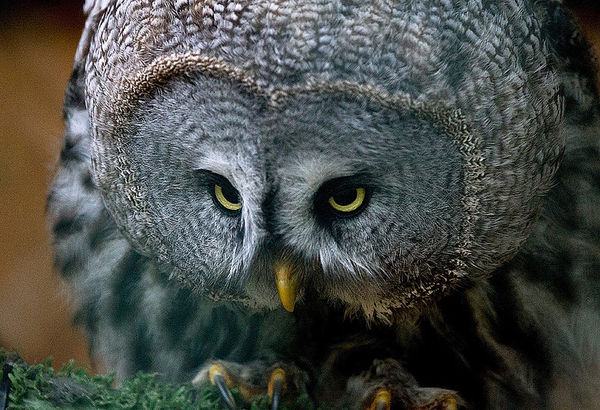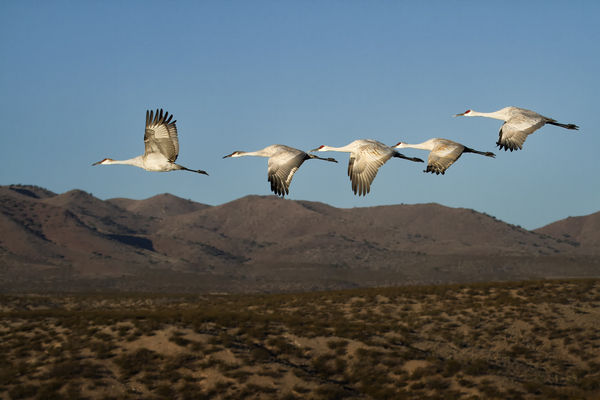Wildlife flop with Canon 100-400
Jan 6, 2013 05:03:20 #
I agree with Wendy2 try a clearer angle of view. The camera is going to always try to focus on the closer object, being the grass in this situation. You'd have to shoot manually or try or spot focus (on the subject, especially the eyes) to get the subject in sharper focus. There may be some glare from the water adding to the soft focus. I'm wondering if a polarizer would benefit here by reducing the glare but, most of all changing your angle would resolve some of these issues. Distracting objects in the foreground and bright sunlight work against this shot. Try shooting in the shade if possible or a different time of day when the sun is less bright. Pre-focusing to where a moving subject is headed may help as well. You choose a beautiful subject with saturated colors.
Jan 6, 2013 05:03:55 #
dellenthompson wrote:
Sigh. I tried to practice wildlife with a new len... (show quote)
IMHO you are missing the point here. I use the 100-400 hand held and under theses circumstances you need to switch to manual focus with the focus set to the centre point. At he moment your camera is autofocusing on different areas at once.
It also helps if you have your camera set on AL-Servo if using AV or TV so it will rapidly correct for movement.
Canon 100-400 L 4.5-5.6 Hand Held

Jan 6, 2013 07:22:04 #
rpavich wrote:
quote=dellenthompson They were dark, grainy unf... (show quote)
Ooooooh! Thanks! All is noted, especially don't test new lens with filter! More to follow!! :-). Dee
Jan 6, 2013 07:22:55 #
Jan 6, 2013 07:24:14 #
Jan 6, 2013 07:24:15 #
Jan 6, 2013 07:25:20 #
washy wrote:
with a new lens why not set the camera to auto and see what that looked like and if was a reasonable sunny day start at 100 iso with white balance set at daylight. then check the histogram and the image on the camera. Then you could experiement from there.
Okay, will do! Thank you!
Jan 6, 2013 07:27:07 #
washy wrote:
if you managed to take pics with that you were hap... (show quote)
I am definitely going to search for a monopod. And do curls with the lensM. :-)
Jan 6, 2013 08:54:57 #
dellenthompson wrote:
Sigh. I tried to practice wildlife with a new len... (show quote)
I don't use that large a lens but when ever I'm shooting wildlife like that I always, especially in that bright environment, use 1/1000 shutter speed and allow the camera to decide the aperture with ISO at 100. The high speed shutter seems to work best for me.
Good Luck.
Jan 6, 2013 09:11:02 #
TimS
Loc: GA
Play around with your metering modes. Are you in scene eval or spot metering? Try spot metering and see how that works for you.
Jan 6, 2013 09:14:15 #
TimS wrote:
Play around with your metering modes. Are you in scene eval or spot metering? Try spot metering and see how that works for you.
This just reminded me; one other way to get a ballpark exposure is to meter off of green grass...it's sort of a "middle tone" too.
Have you heard about the "sunny 16 rule"? it's also pretty useful when you've got nothing else to base your exposure on.
Jan 6, 2013 10:38:03 #
Jan 6, 2013 11:05:00 #
washy wrote:
if you managed to take pics with that you were hap... (show quote)
The learning curve with the 100-400 is steep and given that there is nothing wrong with the lens then it will take lots and lots of practice in all kinds of light and subject conditions. Hang in there because the results will eventually amaze you. I've been using this lens for 2 years on a Canon 7D body. Last month I captured this image hand held at 150mm, F8, 1/1000 in aperture priority, evaluative metering. I kinda like it.
At Bosque del Apache in New Mexico early December low light

Jan 6, 2013 11:24:34 #
Hyperiguana
Loc: South Carolina
Reading your post and others, I would like to bring some things to mind:
1) Your ISO is extremely high, and the "graininess" may be coming from an over-sensitive sensor. You should try to use the lowest ISO possible to get the shot you want, as that will reduce "spill over" and "electronic noise".
2) I have found that having a CPL (Circular Polarizing Lens/filter) can be a shot saver. Since glare off of surfaces usually polarize, you can adjust the filter until it excludes most, if not all the glare. Plus its a relatively inexpensive filter and can impart some protection to your lens' front element.
3) Manual focusing can be handy sometimes for on-the-fly adjustments, however it can be tricky, especially if you have corrected vision or are trying to get fine detail at a distance. But if you want a more automatic setting and have time to do a little camera option set-up, reduce your AF/metering points down to a central point. There is nothing that says that you have to use *all* of them. I've done this before trying to shoot between branches and such.
4) I'm not sure where the grass is in the foreground, but if you are trying to shoot "through" something, try to be as close to that "something" as possible. By doing this and adjusting your f-stop (and thus your depth of field) you can minimize, if not eliminate, undesirable blurry "somethings" from your shot.
5) Taking shots in manual modes can be like making pancakes, sometimes the first one or two get burned. So make the best of it, do a couple shots in full auto mode, see what the camera uses for its settings (iso, f-stop, exposure, etc.) and use those for your initial manual set-up (adjusting as you see fit). This usually gives you a pretty solid starting point.
I hope you find this useful, I know I rambled a bit. Please post more photos so we can see what you have come up with! Happy shooting!
1) Your ISO is extremely high, and the "graininess" may be coming from an over-sensitive sensor. You should try to use the lowest ISO possible to get the shot you want, as that will reduce "spill over" and "electronic noise".
2) I have found that having a CPL (Circular Polarizing Lens/filter) can be a shot saver. Since glare off of surfaces usually polarize, you can adjust the filter until it excludes most, if not all the glare. Plus its a relatively inexpensive filter and can impart some protection to your lens' front element.
3) Manual focusing can be handy sometimes for on-the-fly adjustments, however it can be tricky, especially if you have corrected vision or are trying to get fine detail at a distance. But if you want a more automatic setting and have time to do a little camera option set-up, reduce your AF/metering points down to a central point. There is nothing that says that you have to use *all* of them. I've done this before trying to shoot between branches and such.
4) I'm not sure where the grass is in the foreground, but if you are trying to shoot "through" something, try to be as close to that "something" as possible. By doing this and adjusting your f-stop (and thus your depth of field) you can minimize, if not eliminate, undesirable blurry "somethings" from your shot.
5) Taking shots in manual modes can be like making pancakes, sometimes the first one or two get burned. So make the best of it, do a couple shots in full auto mode, see what the camera uses for its settings (iso, f-stop, exposure, etc.) and use those for your initial manual set-up (adjusting as you see fit). This usually gives you a pretty solid starting point.
I hope you find this useful, I know I rambled a bit. Please post more photos so we can see what you have come up with! Happy shooting!
Jan 6, 2013 11:40:41 #
I shoot wildlife and I use a 7D with the 100-400 and find that the use of a tripod is a must. Occasionally you can get away with hand held but not often. Also as one other person pointed out the camera was focusing on the grasses and not the birds. Keep your ISO as low as you can, use a tripod and practice practice and practice some more eventually it will all come together. You have great gear so don't give up.
If you want to reply, then register here. Registration is free and your account is created instantly, so you can post right away.





